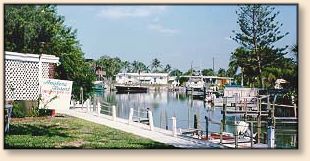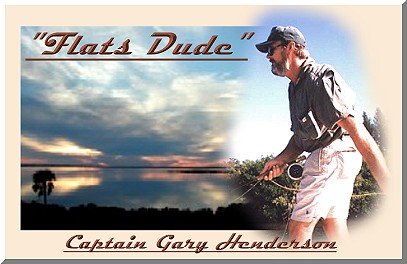|
Pretty scary stuff, if you ask me.
Along about 1528 A. D., Governor Panfilo
de Naraez and Cabenza de Vaca, a couple
of Spanish discoverers, went about to
colonize North America from an earlier
discovered harbor by Juan Ponce de León.
However, one of our late hurricanes, sounds
like to me, got caught up in the mainsail
and blew them off course. Instead of arriving
at Juan's harbor (what is now known as Charlotte
Harbor), they landed five leagues (one league
equals 2.6 statute, or legal miles) north on
a barrier island, that is now Englewood,
Florida. According to the Florida Township
survey of 1896, Charlotte Harbor is exactly
five leagues (thirteen miles) south of Stump
Pass, one of today's premier snook fishing
locations.
To further complicate matters, the two Spaniards
didn't make the stop in Havana to re-supply the
ships with food due to that particular storm that
took them into the Gulf of Mexico. Then to make
matters worse, they ran into real Florida natives...
Indians. They really didn't take too kindly that
the Spaniards were about to mess up their fishing,
farming and hunting. (All of this journey can be
read in a translation by Fanny Bandelier (1905),
on a very interesting website I found as I began
researching the history of Englewood, Lemon Bay
and Stump Pass; three areas I've fished with
positive results.) Here is the
website.
Sorry, I didn't mean to get off on a history
lesson, but the more I read of their misfortunes,
the more I began to think back on one of the
fishing trips I made to that beautiful place
many years ago. I regret that I hadn't read
this informative translation prior to the trip.
I shall make the trip once again in the near
future, and I'm sure the painting I now have
stored in my memory will be realized after the
eventual trip.
If I recall correctly, it was in the late
seventies. I had been invited by an old,
fishing friend to come down to Englewood. I
remember the seductive words of Dr. Steve
Garsey distinctly. "The snook are jumping in
the boat!" That didn't take much arm twistin'
for me to pack my tackle and join Steve and
his family three hours to the southwest on the
Gulf Coast of Florida.

I had fished the areas of Pine Island, Bokeelia
(Bo-keel-ya), Jug Creek, Matlacha (Mat-la-shay)
and Pejuan Cove. Areas that my dad and others
had introduced me to, and some I had found on
my own. All beautiful and strange, and all south
of the area where I was about to meet up with
Steve for three days, and mostly nights, of
searching out the snook.

Five in the afternoon I arrived just east and
north of Englewood. I drove a little slower
now as I memorized the area. Quiet streets,
old Florida folk waved at each vehicle that
passed them as they sat on white-railed, front
porches. Laid back, another day in paradise,
swaying palms, the smells of the Gulf of Mexico
wafted in the western sea breeze. "I should
live here one day" I thought to myself. An
old bridge that separated the mainland from
the barrier island carried me to even narrower
roads and slight paths that revealed glimpses,
just past the mangroves, of Lemon Bay. The tide
was coming in and the smaragdite-colored waters
traveled under that bridge and through passes
named Blind and Stump, filling the bay with
waters from the Gulf. The moon would be full
tonight, the spring tide running strong, and
the snook would line the mangrove shoreline
where long, finger-like docks, each with
floodlights, reached out into the darkness
of the bay. The snook would be there, waiting
to ambush small baits and our plugs.
 The sound of pea-gravel under the tires of
my Blazer interrupts my daydream as I pull
into the driveway of the Angler's Resort.
"Very nice," as I looked for Steve's cottage
number. Eighteen units sitting on the back-waters
of the bay, each looking typically like the
old-style Florida homes, only reduced in size.
The sound of pea-gravel under the tires of
my Blazer interrupts my daydream as I pull
into the driveway of the Angler's Resort.
"Very nice," as I looked for Steve's cottage
number. Eighteen units sitting on the back-waters
of the bay, each looking typically like the
old-style Florida homes, only reduced in size.
After exchanging pleasantries, we go over
our plan of attack scheduled early the next
morning. The tide will change at three am,
and we have to be there before the turn. High
tide falling is best. The snook will gather
under the docks and hide on the leeward side
of pilings, then blast the mullet and shrimp
that wash past them in the strong current as
Lemon Bay washes out into the dark Gulf of Mexico.

Two-thirty finally came as I lay in bed
watching the alarm clock. Anticipation
was my insomnia, but I rarely sleep before
one of these trips. Things to remember,
important things not to forget…it was to
be a new learning curve this very, early
morning.
Steve's little aluminum boat puttered out
and across Lemon Bay as the long-fingered
docks came up to meet us in the looming fog.
I thought how surreal it appeared with the
full moon's glow. Nothing seemed to be as
it was. Had I really awakened in time for
all of this, or was I still lying in the
warm bed at the cottage asleep and was only
dreaming?
As Steve lowered the small trolling motor
into the phosphorescent brine, he explained
that I needed to cast my top-water plug past
the light and pull it through, taunting the
fish. I hadn't much experience in that type
of accuracy, especially in the darkness.
Several times I hit the lights, hoping not
to break them. I cast several plugs on top
of docks, snagging the boards and having to
break them off. Fifteen or twenty times, then
finally, after I had lost several dollars worth
of Mirrolures, Creek Chubs and others, a slight
amount of accuracy was learned, and I began to
aim and hit in the pattern of water where I
needed to reach the snook that could be heard
crashing and throwing water from underneath
the docks.
It sounded like night thunder in the early
morning hours. Huge fish in the twenty-pound
class nailing anything that went by their
hiding places. Then suddenly one smoked the
gray and white plug that passed him. Drag
ripped from my reel and he was gone as quickly
as I had set the hook. I firmly believe the
first thing old mama snook teaches her young
is a double half-hitch. Steve and I successfully
landed three fish that morning. As the orange
ball of the sun appeared on eastern horizon,
it was time to return home and restock the
many plugs that were lost.

At three the next morning, the sights and
sounds were the same, but we went past the
docks and on to Stump Pass to drift live,
pig fish along the currents of the outgoing
tide. We beached the skiff sideways. A full
moon was directly above us illuminating the
ribbon of white sand. The fog failed to cloak
us, revealing a sky of ebony littered with a
million stars. Back to the west and far over
the gulf, a thunderhead towered in the darkness,
lit externally by a ghost-white moon, then
flashed sporadically by bolts of lightning
that scattered from points high in the faraway
storm.
A boat's engine was heard in the distance,
and then came to rest on the point of the
pass several hundred feet north of us. A
few minutes pass and the dark shadow of a
man walks behind us lit only by the overhead
moon.
"Mornin'..."

The next sound we heard was the scream of
the drag from his bait-caster and the
splashing, head-shake of a rather large
snook exploded through film of the water.
He walked past us again, returning to his
boat to ice down the twenty-pound snook.
Then again, with only one cast for each fish.
I had a flashlight ready to reveal his lure
of choice and when I lit it, he had secretly
cupped it in his hand exposing it to no one.
Back then, the limit on snook was four fish
per person. On his fourth fish, he stopped
and said, "I will only tell you guys that
the lure is red and white." That's all that
was said, then he puttered away. Later on
that morning, Steve and I bought every style
and brand of red and white, top-water lures
in Englewood and surrounding areas.
The drive down there had taken three hours
and the three days that I was there seemed
to pass quicker than the drive. But it was
Sunday and I had to return to the inner core
of the State and leave Steve to another week
of listening to "night thunder."
When I return to Lemon Bay and Stump Pass in
the near future, I want to walk those areas
on the beaches where it all started. I want
to examine the site where the Native Americans
of Florida once left footprints on that very
sand where they harvested the once abundant
fishes and clams. I want to listen to the
waters and mangroves tell the story, if it will.
See y'all next week. ~ Capt. Gary
About Gary:
Gary grew up in central Florida and spent much
of his youth fishing the lakes that dot the area.
After moving a little closer to the coast, his
interests changed from fresh to salt. Gary still
visits his "roots" in the "lake behind the house."
He obtained his captain's license in the early '90's
and fished the blue waters of the Atlantic for a little
over twelve years. His interests in the beautiful shallow
water flats in and around the famous Mosquito Lagoon came
around twenty-five years ago. Even though Captain Gary
doesn't professionally guide anymore, his respect of the
waters will ever be present.
Gary began fly fishing and tying mostly saltwater
patterns in the early '90's and has participated as
a demo fly tier for the Federation of Fly Fishers
on numerous occasions. He is a private fly casting
and tying instructor and stained glass artist,
creating mostly saltwater game fish in glass.
|







 The sound of pea-gravel under the tires of
my Blazer interrupts my daydream as I pull
into the driveway of the Angler's Resort.
"Very nice," as I looked for Steve's cottage
number. Eighteen units sitting on the back-waters
of the bay, each looking typically like the
old-style Florida homes, only reduced in size.
The sound of pea-gravel under the tires of
my Blazer interrupts my daydream as I pull
into the driveway of the Angler's Resort.
"Very nice," as I looked for Steve's cottage
number. Eighteen units sitting on the back-waters
of the bay, each looking typically like the
old-style Florida homes, only reduced in size.